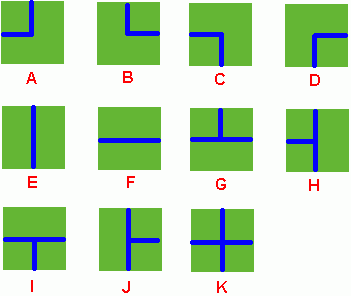hdu 1198 Farm Irrigation
来源:互联网 发布:淘宝店上传数据包 编辑:程序博客网 时间:2024/04/27 13:38
Farm Irrigation
Time Limit: 2000/1000 MS (Java/Others) Memory Limit: 65536/32768 K (Java/Others)Total Submission(s): 3643 Accepted Submission(s): 1595
Problem Description
Benny has a spacious farm land to irrigate. The farm land is a rectangle, and is divided into a lot of samll squares. Water pipes are placed in these squares. Different square has a different type of pipe. There are 11 types of pipes, which is marked from A to K, as Figure 1 shows.

Figure 1
Benny has a map of his farm, which is an array of marks denoting the distribution of water pipes over the whole farm. For example, if he has a map
ADC
FJK
IHE
then the water pipes are distributed like

Figure 2
Several wellsprings are found in the center of some squares, so water can flow along the pipes from one square to another. If water flow crosses one square, the whole farm land in this square is irrigated and will have a good harvest in autumn.
Now Benny wants to know at least how many wellsprings should be found to have the whole farm land irrigated. Can you help him?
Note: In the above example, at least 3 wellsprings are needed, as those red points in Figure 2 show.

Benny has a map of his farm, which is an array of marks denoting the distribution of water pipes over the whole farm. For example, if he has a map
ADC
FJK
IHE
then the water pipes are distributed like

Several wellsprings are found in the center of some squares, so water can flow along the pipes from one square to another. If water flow crosses one square, the whole farm land in this square is irrigated and will have a good harvest in autumn.
Now Benny wants to know at least how many wellsprings should be found to have the whole farm land irrigated. Can you help him?
Note: In the above example, at least 3 wellsprings are needed, as those red points in Figure 2 show.
Input
There are several test cases! In each test case, the first line contains 2 integers M and N, then M lines follow. In each of these lines, there are N characters, in the range of 'A' to 'K', denoting the type of water pipe over the corresponding square. A negative M or N denotes the end of input, else you can assume 1 <= M, N <= 50.
Output
For each test case, output in one line the least number of wellsprings needed.
Sample Input
2 2DKHF3 3ADCFJKIHE-1 -1
Sample Output
23
Author
ZHENG, Lu
Source
Zhejiang University Local Contest 2005
Recommend
Ignatius.L
题目大意。有很多水管。由题目中给出。问至少需要多少水源才能保证整个田地都能灌溉到。
#include <stdio.h>int mem[10000];//用于建立并查集int msize[10000];//记录集合中水管数int mway[10000][5];//记录每块田里的水管类型int sum;//记录集合数目。即所需水源数int finder(int x)//找根节点{ int i,j,t; i=x; while(mem[i]!=i) i=mem[i]; j=x; while(j!=i) { t=mem[j]; mem[j]=i; j=t; } return i;}void toone(int a,int b)//加入集合{ int r1,r2; //printf("a:%d b:%d\n",a,b); r1=finder(a); r2=finder(b); //printf("r1:%d r2:%d\n",r1,r2); if(r1==r2) return ; if(msize[r1]>msize[r2]) { mem[r2]=r1; msize[r1]+=msize[r2]; } else { mem[r1]=r2; msize[r2]+=msize[r1]; } sum--;}int main(){ int i,j,t,m,n; char c; while(scanf("%d%d",&m,&n)!=EOF) { getchar(); if(m==-1&&n==-1) break; sum=m*n;//sum初始为合并前的集合数 for(i=1; i<=sum; i++) { msize[i]=1; mem[i]=i; for(j=1; j<=4; j++) mway[i][j]=0; } for(i=1; i<=m; i++) { for(j=1; j<=n; j++) { scanf("%c",&c); t=(i-1)*n+j;//一维数组转化为二维数组。方便并查集。 //注意不是i*j呀!! switch(c)//记录水管类型 { case 'A': mway[t][1]=mway[t][2]=1; break; case 'B': mway[t][1]=mway[t][3]=1; break; case 'C': mway[t][4]=mway[t][2]=1; break; case 'D': mway[t][4]=mway[t][3]=1; break; case 'E': mway[t][4]=mway[t][1]=1; break; case 'F': mway[t][3]=mway[t][2]=1; break; case 'G': mway[t][1]=mway[t][2]=mway[t][3]=1; break; case 'H': mway[t][1]=mway[t][2]=mway[t][4]=1; break; case 'I': mway[t][4]=mway[t][2]=mway[t][3]=1; break; case 'J': mway[t][1]=mway[t][4]=mway[t][3]=1; break; case 'K': mway[t][1]=mway[t][2]=mway[t][3]=mway[t][4]=1; } } getchar(); } for(i=1; i<=m; i++) for(j=1; j<=n; j++) { t=(i-1)*n+j; if(mway[t][1]==1)//如果相通则加入集合 if(i>1&&mway[(i-2)*n+j][4]==1)//ио toone(t,(i-2)*n+j); if(mway[t][2]==1) if(j>1&&mway[(i-1)*n+j-1][3]==1)//вС toone(t,(i-1)*n+j-1); if(mway[t][3]==1) if(j<n&&mway[(i-1)*n+j+1][2]==1)//ср toone(t,(i-1)*n+j+1); if(mway[t][4]==1) if(i<m&&mway[i*n+j][1]==1)//об toone(t,i*n+j); } printf("%d\n",sum); } return 0;}改良后的代码
#include <stdio.h>int mem[10000];//用于建立并查集int msize[10000];//记录集合中水管数int mway[10000][5];//记录每块田里的水管类型int sum;//记录集合数目。即所需水源数int finder(int x)//找根节点加路径压缩{ int i,j,t; i=x; while(mem[i]!=i) i=mem[i]; j=x; while(j!=i) { t=mem[j]; mem[j]=i; j=t; } return i;}void toone(int a,int b)//加入集合{ int r1,r2; //printf("a:%d b:%d\n",a,b); r1=finder(a); r2=finder(b); //printf("r1:%d r2:%d\n",r1,r2); if(r1==r2) return ; if(msize[r1]>msize[r2]) { mem[r2]=r1; msize[r1]+=msize[r2]; } else { mem[r1]=r2; msize[r2]+=msize[r1]; } sum--;}int main(){ int i,j,t,m,n; char c; while(scanf("%d%d",&m,&n)!=EOF) { getchar(); if(m==-1&&n==-1) break; sum=m*n;//sum初始为合并前的集合数 for(i=1; i<=sum; i++) { msize[i]=1; mem[i]=i; for(j=1; j<=4; j++) mway[i][j]=0; } for(i=1; i<=m; i++) { for(j=1; j<=n; j++) { scanf("%c",&c); t=(i-1)*n+j;//一维数组转化为二维数组。方便并查集。 //注意不是i*j呀!! //这样按方向标记代码更简洁 if(c=='A'||c=='B'||c=='E'||c=='G'||c=='H'||c=='J'||c=='K') mway[t][1]=1;//上 if(c=='A'||c=='C'||c=='F'||c=='G'||c=='H'||c=='I'||c=='K') mway[t][2]=1;//左 if(c=='B'||c=='D'||c=='F'||c=='G'||c=='I'||c=='J'||c=='K') mway[t][3]=1;//右 if(c=='C'||c=='D'||c=='E'||c=='H'||c=='I'||c=='J'||c=='K') mway[t][4]=1;//下 } getchar(); } for(i=1; i<=m; i++) for(j=1; j<=n; j++) { t=(i-1)*n+j; if(mway[t][1]==1)//如果相通则加入集合 if(i>1&&mway[(i-2)*n+j][4]==1)//查找了上就不用查找下了 toone(t,(i-2)*n+j); if(mway[t][2]==1) if(j>1&&mway[(i-1)*n+j-1][3]==1)//查找了左就不用查找右了 toone(t,(i-1)*n+j-1); } printf("%d\n",sum); } return 0;}- HDU 1198 Farm Irrigation
- hdu 1198 Farm Irrigation
- hdu 1198 Farm Irrigation
- HDU--1198Farm Irrigation
- hdu 1198 Farm Irrigation
- HDU 1198-Farm Irrigation
- HDU 1198 Farm Irrigation
- hdu 1198 Farm Irrigation
- hdu 1198 Farm Irrigation
- HDU 1198 Farm Irrigation
- HDU 1198 Farm Irrigation
- HDU 1198 Farm Irrigation
- hdu 1198 Farm Irrigation
- hdu 1198 Farm Irrigation
- hdu 1198 Farm Irrigation
- hdu 1198 Farm Irrigation
- hdu(1198)Farm Irrigation
- hdu 1198 Farm Irrigation
- iostat 命令多平台详解
- svm
- 虚拟内存和物理内存
- JavaScript:Div层拖动效果
- usb传输方式
- hdu 1198 Farm Irrigation
- 2011阿里巴巴集团实习生招聘笔试题 C&C++
- java 调用 ffmpeg 进行视频转换以及截图
- 计算机技术未来15年发展的估测
- ERWIN设置字段顺序
- VC2005从开发MFC ActiveX ocx控件到发布到.net网站的全部过程
- Windows Embedded CE 6.0操作系统的架构
- sar命令详解
- pcDuino + busybox 成功搭建最小linux系统


